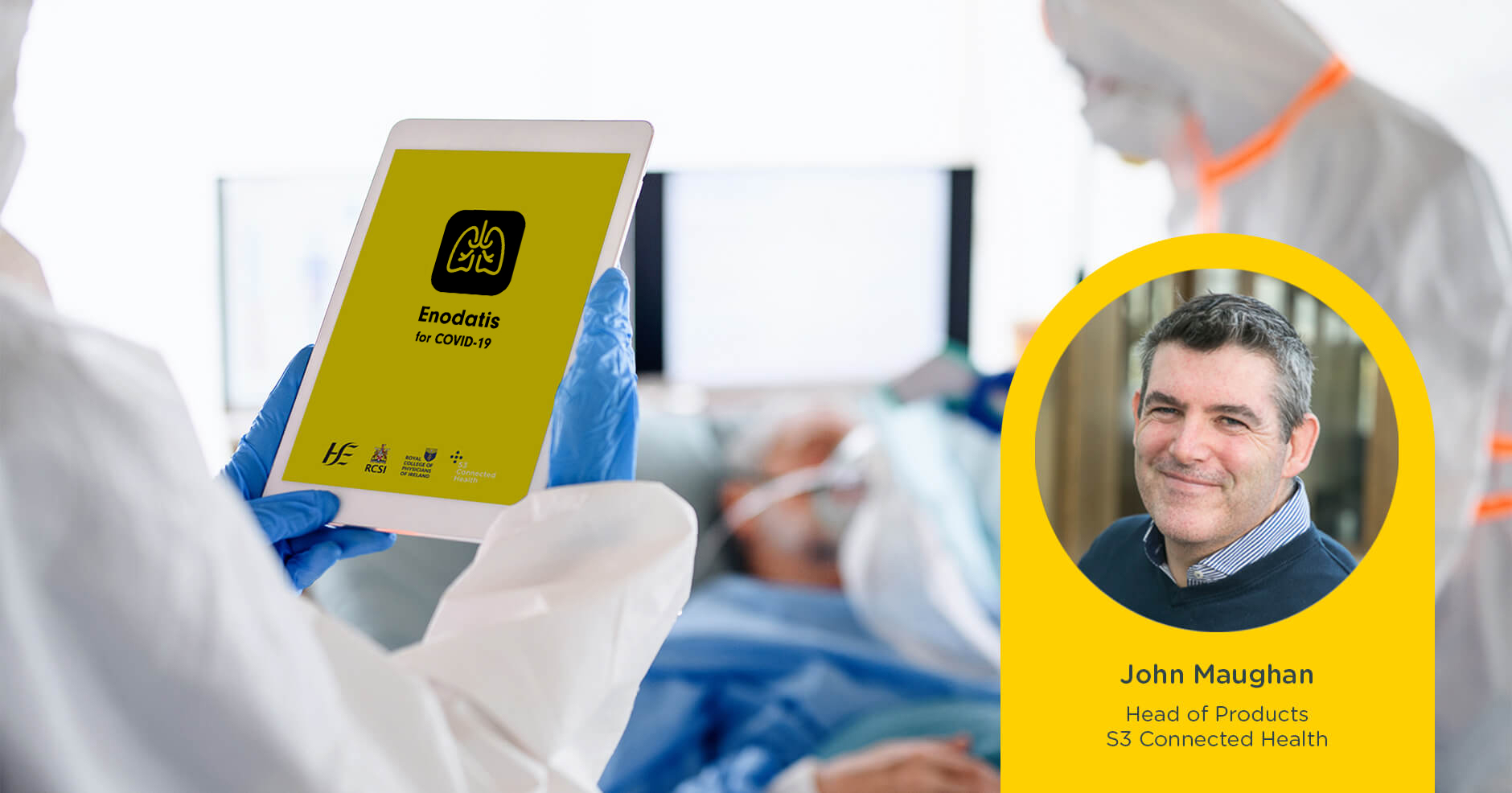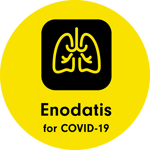It all started with a call for help at 10pm on a Saturday night. The COVID-19 pandemic was beginning to spread rapidly in Ireland and senior respiratory clinicians at Beaumont Hospital, Dublin, were searching for a technology solution that could help them deal with the situation.
With time of the utmost importance, our teams rallied the very next morning, starting the planning process for what would eventually become our newest clinical support tool.
For the next week, our teams across the globe worked both day and night, alongside clinical consultants and frontline staff, to help them in the fight against the pandemic.
The result was Enodatis: a clinical support tool that helps healthcare professionals in hospitals quickly triage COVID-19 patients with a simple, web-based application on their smartphones. It went live rapidly in six Irish hospitals, and the solution remains on standby for others in the event of a second wave. But more than that, the technology has also laid the groundwork for future innovation in the field beyond the 2020 pandemic.
What’s most remarkable about Enodatis is that it came to fruition in less than a fortnight. That’s not to say it was easy – far from it. Creating a successful clinical support tool in little over a week was a significant challenge for everyone involved. But this experience will prove incredibly valuable in the future for companies looking to respond quickly in a crisis with a usable digital health solution.
Here’s how we created our solution, some of the problems we faced, and some tips on what you can learn from our experience.
What type of digital health solution was needed?
Given the urgency of the situation, our priority was to focus on the most essential capabilities for the solution – leaving other ‘nice-to-have’ features aside for the time being. We quickly began to communicate with teams on the ground to identify their struggles and better understand the disease.
Clinical teams explained that the highly infectious nature of COVID-19 was causing an influx of patients. With all new patients needing assessment to gauge the severity of their condition, followed by constant oversight to monitor for any sudden worsening of symptoms, existing healthcare resources were becoming stretched and existing triage processes overwhelmed.
These initial conversations made it clear that any proposed tool needed to help triage patients, assess risks at speed, and allow clinicians to collaborate for better monitoring and care of patients — all in a way that used resources efficiently and integrated into existing clinical workflows.
Going from concept to deployment in ten days
Ten days is a very tight schedule to come up with any solution, let alone a clinical support tool for a disease as new as coronavirus. But with all the teams involved fully united against the common enemy of COVID-19, we were totally committed to the task from the outset.
Addressing the specific needs outlined above meant gathering the expertise of staff from a range of different departments on countless conference calls. From the hospital side, that included hospital consultants and non-consultant hospital doctors; bed, ward, and hospital managers; hospital IT services and data security personnel; medical engineering staff; nurses; and hospital administration staff - to name but a few. These were joined by a range of managers, analysts, UX specialists, software engineers, and regulatory and operations experts from S3 Connected Health.
As well as personnel, existing technology was also instrumental in the success of the project. Our Affinial platform, in particular, was a solid starting point that proved vitally important in the development of Enodatis. Affinial is a cloud-based platform that we use to deliver digital health solutions and services around a disease, therapy, or connected medical device; allowing us to capture, securely host, and centrally manage patient and device data.
In this particular case, that meant we could easily centralize, optimize, and build on existing operations in a way that was proven to be compliant; boosting efficiency and enabling a rapid turnaround.
Creating a clinical support tool for COVID-19
Days (and nights) of video calls, whiteboard scribblings, prototype building, and rigorous testing and compliance eventually resulted in the creation of a new web-based clinical support tool for respiratory care of COVID-19 patients.
Enodatis is designed to help specialist respiratory clinicians, guide those who are not specialists in respiratory medicine, and provide teams on the ground with oversight of their current patients and capacity, as well as forecasts of disease progression.
Underneath it all is a measure of patient status called the Critical Care Index (CCI). Stratifying patients with CCI gives clinicians an immediate picture of which patients are most at risk, ensuring that respiratory team leaders can allocate and plan resources accordingly.
CCI assessments are designed to be updated on an ongoing basis in real time as new vital-signs data becomes available, allowing clinicians to visualize trends and track disease progression. But this also provides early warning for adverse outcomes, as well as clear oversight of longitudinal patient outcomes and timely, high-level clinical guidance. In short, it gives clinicians a real chance to intervene before things get worse.
What we learned
Every stage of the development process brought its own learnings. Firstly, with such a wide range of teams involved in the creation of Enodatis, the engagement of stakeholders from an early stage was key to its success. Building trusted relationships early on with clinical teams, in particular, was extremely valuable. It’s important to keep front of mind that it’s clinicians who will ultimately use any new tool, and understanding the clinical context of any potential solution allows it to be integrated more seamlessly into existing treatment pathways.
Secondly, while early prep work is important, it’s crucial not to get bogged down in first steps. The answer is to have robust processes, agile methodologies, and the right platforms in place to guarantee quality and quick progression, even when operating at speed. More than that, this flexibility and adaptability will also allow you to build up valuable experience of a range of different conditions and situations.
Regulation and certification are of course a crucial step in the creation of any new device. In the case of Enodatis, regulators were prompt and extremely supportive, with derogation achieved quickly and classification following soon after. With medical device regulations within the EU set to undergo significant changes in May 2021, it’s vital to plan your regulatory pathway as early as possible in the process.
Data protection approvals were needed both at a national and local level, which was a complex process, but given the nature of the emergency, there was a willingness on all sides to make it happen. In future, a system of centralized security standards or certificates that are readily accepted across different hospitals would speed up processes and allow for quicker responses during crisis situations.
Our final piece of advice? Keep your teams aligned and your goal front of mind. We had the utmost respect for clinical teams on the ground who were putting their lives on the line, and knowing we could help make a difference spurred us on throughout the process. Despite the difficulties of long hours and remote working with teams scattered across the world, our goal kept us fully aligned and committed – allowing us to do our best work and ultimately help clinicians save lives.
John Maughan
Head of Products
S3 Connected Health



